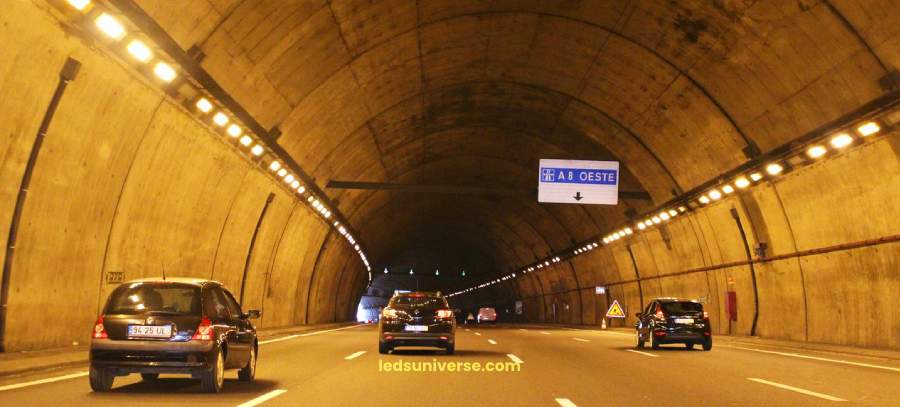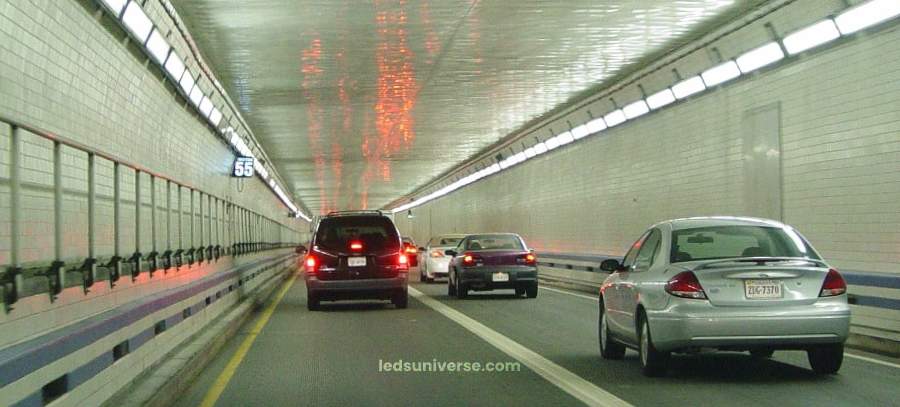As vehicles glide through the darkened expanse of a tunnel, it’s the lighting that acts as their guiding star, ensuring safety and smooth navigation. Tunnel lighting is more than just a practical necessity; it is a critical element that enhances the driving experience and underscores the brilliance of modern infrastructure
Illumination in tunnels is not just about visibility but also about creating an environment that enhances driver comfort, reduces accidents, and ensures smooth traffic operations. The various aspects of tunnel lighting are examined, including determining the number of lights needed, safety considerations, control systems, and other relevant factors.
Reach out for free lighting consultation
Table of Contents
ToggleThe number of lights required for a tunnel depends on several critical factors, including the tunnel’s length, width, and height. These dimensions influence the intensity and distribution of light needed to achieve optimal visibility. Longer tunnels require more lighting to ensure that drivers can see clearly throughout their journey. Additionally, the width and height of the tunnel determine the spacing of the lights, as well as their type and brightness.

Lighting calculations for tunnels typically involve using standards set by organizations such as the Illuminating Engineering Society (IES) or the International Commission on Illumination (CIE). These standards provide guidelines for achieving the appropriate light levels. The use of specialized lighting calculation tools and software can help in determining the exact number of fixtures required. Factors such as light intensity, distribution patterns, and uniformity are considered in these calculations to ensure that the lighting meets safety requirements.
Practical examples from existing tunnels can offer insights into effective lighting setups. For instance, some modern tunnels use advanced LED lighting systems to provide consistent illumination while minimizing energy consumption. Case studies of these installations demonstrate how different lighting configurations and technologies can be applied to various tunnel designs, providing valuable lessons for new projects.
Emergency lighting is a critical component of tunnel lighting systems. It ensures that adequate illumination is available in the event of an emergency, such as a power outage or accident. Standards require that emergency lighting be capable of operating independently of the main lighting system, often through backup power sources like batteries or generators. Proper placement and maintenance of emergency lights are essential for effective evacuation and emergency response.
Tunnels are vulnerable to vandalism and accidental damage, which can impact lighting systems. To address these issues, lighting fixtures should be designed to withstand physical impacts and tampering. High-quality, durable materials and robust housing are essential for ensuring that lights remain functional and safe. Additionally, integrating protective features such as shatter-resistant lenses and secure mounting can enhance the resilience of the lighting system.
Regular maintenance and testing are crucial for ensuring that tunnel lighting systems operate effectively over time. Routine inspections help identify and address issues such as bulb failures, dirt accumulation, and electrical faults. Scheduled maintenance prevents potential problems and ensures that the lighting system remains reliable and compliant with safety standards.

Modern tunnel lighting systems often incorporate automated control systems to manage lighting levels based on real-time conditions. These systems use sensors to monitor factors such as traffic volume, ambient light levels, and weather conditions. By adjusting the lighting in response to these variables, automated controls can optimize energy use and maintain appropriate illumination throughout the tunnel.
Integration with traffic management systems allows for dynamic adjustments to tunnel lighting based on traffic flow and congestion. For example, lighting levels can be increased during periods of heavy traffic or reduced during low-traffic periods to save energy. This integration enhances overall traffic management and contributes to a smoother driving experience.
Remote monitoring and control capabilities enable operators to oversee and manage tunnel lighting systems from a central location. This feature allows for real-time adjustments and troubleshooting without the need for on-site inspections. Remote access also facilitates quick response to any issues that may arise, ensuring that the lighting system remains in optimal condition.
Solid State Lighting (SSL) technology has significantly advanced over the years, leading to notable improvements in lighting quality. SSL-based LED lights provide superior coloration compared to traditional outdoor lighting alternatives like High-Pressure Sodium (HPS) lamps. The enhanced light quality offered by SSL technology is particularly valuable for both drivers and pedestrians. Consequently, many metropolitan areas have chosen to invest in LED lighting to improve their transportation networks and make public tunnel areas more attractive and safer.
High-Intensity Discharge (HID) lights, such as Metal Halide (MH) and HPS lamps, have traditionally been the mainstay of tunnel lighting due to their high illuminance levels. These fixtures are known for their mechanical durability and cost-effectiveness. Typically, MH and HPS luminaires are rated up to 400W per fixture to meet tunnel lighting requirements. However, our LED lights, with a power rating of 130W-140W, can deliver comparable performance while offering additional benefits.
High-quality LED luminaires have an impressive rated lifespan of approximately nine years. Their efficiency is another significant advantage, with minimal disparity between power output and input, resulting in lower lifetime costs.
LED tunnel lighting systems offer two primary benefits over HID lights: superior light quality and reduced impact on traffic flow. LEDs provide uniform lighting throughout the tunnel, eliminating the glare and shadowing often associated with conventional HID lights. Advanced optical modeling and sophisticated light-throw designs ensure balanced and even lighting patterns. Each LED module features customized beam patterns and efficient light sources, enabling the production of focused light without disturbing glare.
LED tunnel luminaires also excel in entrance and exit regions, offering refined light control that helps drivers adapt comfortably between the tunnel and external environments—an area where HPS and MH lights fall short. Additionally, LEDs are less prone to failure compared to MH and HPS systems, minimizing the likelihood of blackouts or shutdowns. This durability reduces maintenance needs, such as frequent re-lamping, and enhances overall security and safety.
Energy efficiency is a significant consideration in tunnel lighting design. Modern lighting technologies, such as LED fixtures, offer substantial energy savings compared to traditional lighting options. LEDs are not only more energy-efficient but also have a longer lifespan, reducing the need for frequent replacements and maintenance.
Minimizing light pollution is another important aspect of tunnel lighting. Properly designed lighting systems reduce light spill and glare, preventing unnecessary illumination of surrounding areas. Shielded fixtures and well-directed light contribute to minimizing the environmental impact and maintaining the natural balance in nearby regions.
The recycling and disposal of old lighting equipment are essential for environmental sustainability. Proper disposal methods help prevent hazardous materials from contaminating landfills. Many lighting manufacturers offer recycling programs or guidance on the proper disposal of lighting components, supporting eco-friendly practices in tunnel lighting maintenance.
Tunnel lighting serves as a vital component in transforming these underground spaces into safe, efficient, and visually appealing environments. The advancements in lighting technology have brought about a new era of illumination, where energy efficiency meets superior light quality. Modern systems, especially those utilizing Solid State Lighting (SSL) technology, not only enhance visibility but also contribute to environmental sustainability. With the ability to dynamically adjust based on traffic conditions and real-time data, these innovative solutions ensure that tunnels are not only bright but smart, paving the way for a future where every journey is safer and more comfortable.
By carefully considering factors such as the number of lights needed, safety features, control systems, and environmental impact, tunnel lighting systems can be optimized to meet the needs of both drivers and maintenance personnel. Advances in technology, particularly with Solid State Lighting, are shaping the future of tunnel lighting, ensuring that it continues to enhance safety and operational efficiency while minimizing its ecological footprint.